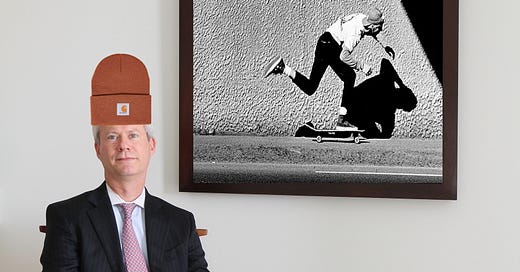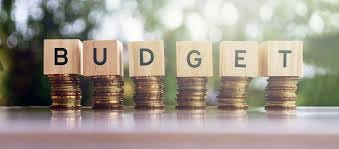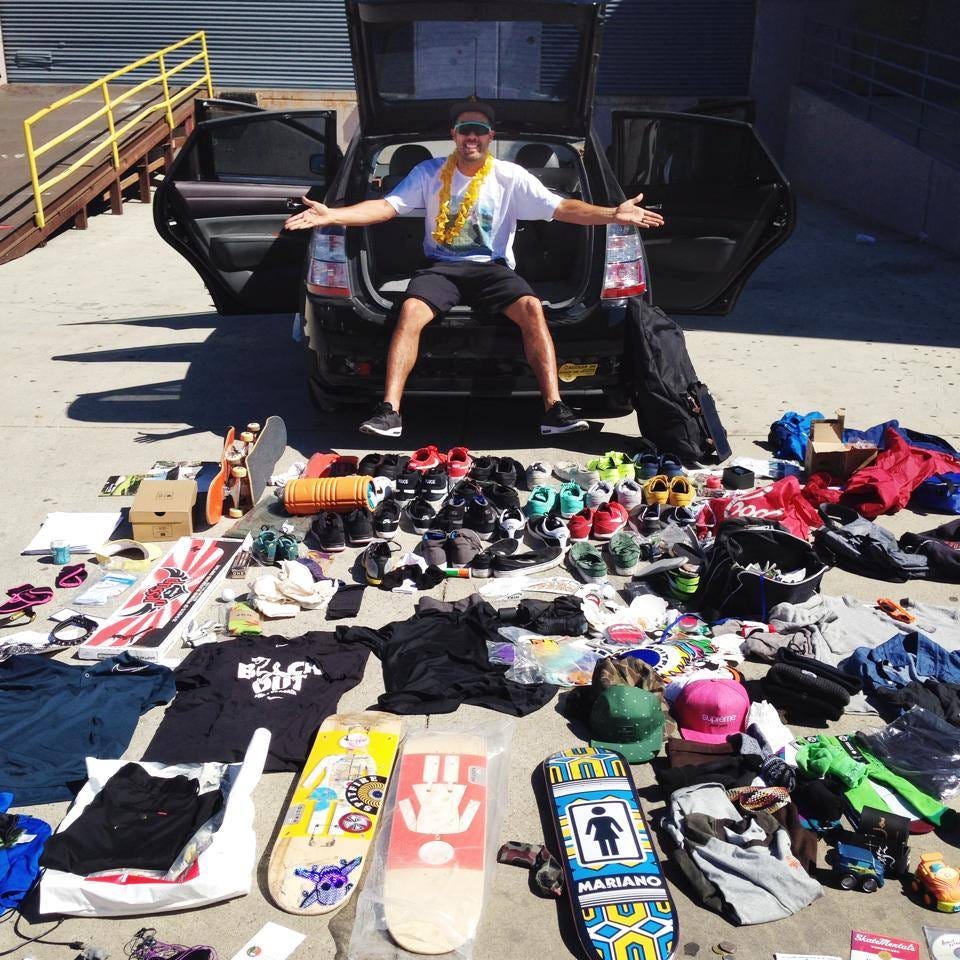Studies show that over 61% of the American population collects things.
My friend’s Dad had his study lined with vintage beer cans and he could tell you something about each one of them. Learning about his collection was a painful lesson in vintage aluminum and rife with tedious tales such as a 30-minute story about this “doozy of a dive in Oklahoma City” where he had the best wings of his life and kept some shitty IPA as a souvenir but I appreciated his passion for can design.
In doing these recent eBay dives I’ve noticed that the more I scroll the more I’m tempted to buy random things that I probably don’t need. Like many folks, I may not consider myself a collector of anything but I have collections of stuff. (Shit, I guess that means I am a collector)
Unlike comic books, custom cars, or trading cards, skateboarding collector culture is still relatively underground or maybe, “behind.” There are online collecting forums, museums, books devoted to collections of decks, and several Instagram tribute accounts devoted to different brands and eras, but the actual collector space is spread out. But Skateboarding does have an annual “con” (SkaterCon) where seekers of rare and cool stuff can converge. If you’re interested, act quickly because it’s coming up this September.
I haven’t attended SkaterCon but Same Old and Bobby Puleo checked it out in 2019. Check the video below.
Most of us can’t attend SkaterCon and there’s no Kelley Blue Book to tell you what an old deck is worth, so figuring out what to collect, how to collect, and what the market price for an item may be is daunting. How are you to know what a good price for a Sean Cliver print or an old Sal Barbier H-Street T-Shirt is… or where to even find that stuff? Hopefully, this piece helps.
So how do you start collecting curating skart and what should you pay for your non-deck skate artifacts?
Anyone reading this with a background in economics is saying “Well, Anthony, something is worth what someone will pay for it!”
They aren’t wrong but they also aren’t necessarily right and I’m hoping the tips I’m providing will offer a better understanding of Skart Value® and a more efficient shopping experience.
Jeff Kendall > Keith Haring
YOUR PROFESSIONAL SKART COLLECTING TIPS
KNOW YOUR BUDGET
Have a dollar amount in mind before you start combing through auctions. You’re supposed to only gamble what you can afford to lose but good news: when you acquire skart you can only win!
OK, you could get burned on a transaction but you know what I mean and hopefully, these tips help.
Only spend what you can afford and look within that comfortable range. If you’re discovering that what you want isn’t lining up with your auction budget, hold tight and see if the prices drop, or maybe settle for less expensive reissues (if available).
Seriously, don’t overpay or impulse buy. You aren’t trying to be skart-poor just to own an old T-shirt.
ASK QUESTIONS, DON’T PUNISH
Unless someone is urgently trying to raise funds on some one-time situation, most sellers of things know how the auction systems work and know questions are coming. They’re pros (sellers), remember.
Seasoned auction folks are aware of their ratings and feedback and how that impacts their selling power, so feel free to ask questions on auction sites and other online shopping destinations.
You might want to know the dimensions of something or get some tidbit about the item and that’s totally cool. Have you seen some of these eBay descriptions? Sometimes they’re like, “I got this a while ago, it’s really cool.” OK, but what size is the thing?
Just don’t be aggro or impatient, especially before you get an item. Why? If there’s a problem with a purchase and you need to file a claim, having a paper trail of aggression isn’t going to help your cause. Also, if someone isn’t being cool in your correspondence, it might make you rethink a potential purchase and sometimes that’s a good thing.
As a general rule, being nice is the move, and also, you might get a deal or some free things thrown in with your purchase and that’s great. No one wants to deal with a punisher, especially when money is involved.
THE A-WORD: AUTHENTICITY
Because we don’t have an agreed-upon grading system for skateboarding stuff* and, unlike buying sneakers on eBay or other reseller sites that offer authentication, your quest for skart is a “let the buyer beware” landscape.
*The Art of Skateboarding does have a serious glossary
I can’t help you verify signatures, dates, or realness, but I can caution you to be mindful of the details in listings and photographs.
Here are a few things to note:
When buying photographs—especially when they aren’t purchased from the artist—be mindful of the printing and paper. Digital prints aren’t necessarily “fake” but there is a lot of forgery happening online. If you’re seeing a Glen E. Friedman flick for sale on “any size stretched canvas you want” and it’s not being sold by GEF, that’s not good. Strive for photos printed on archival paper and of course, if they’re signed, that’s a nice assurance.
*Photographer people, if you want to correct me or clarify here, hit up the comments and I’ll edit the post.
Old shirts are going to have old tags and also, they’re often single-stitched. Usually, those direct-to-garment digital repros are easy to spot because they’re priced low and offered in a variety of sizes, but occasionally someone will try to pass them off as an OG. You’ll also encounter shirts that are “without a tag” which could be a normal thing that happens to an old garment that’s been washed a bunch or perhaps someone removed it for comfort, but that’s often a red flag.
Read the descriptions and compare photos to other listings and auctions. For example, if you’re looking for a sold-out Strangelove print you can pressure test a listing against the photos posted on Strangelove’s site and Instagram account. Do the signatures and colors line up? Sure, screens lie, but this is going to help.
You’re bound to find old sketches, paintings, and art that weren’t signed by the artist. Is their rampant Gonz forgery on eBay? I don’t think so but a signed work is always a.. well, it’s a sign that something is legit. Also, if you’re buying a work from someone directly, make sure they sign that shit!
Check the ratings of the seller as well as the feedback. This was mentioned earlier but it’s a massive help. Someone with little feedback or past auctions? That could be a sign of trouble—could be, I’m not trying to be an asshole.
TRANSPORTATION BLUES
Shipping costs are high—we know that. Local pick-ups are a way around the fees but also, that can be awkward, so don’t go that route unless you have a good vibe about going to a rando’s home to procure goods.
Also, beware of gassed-up shipping and “handling” fees. You can get quotes online to decide if what someone is charging is fair but also, be mindful of their time and materials. For example, you might find that a poster will cost $9 7 change to get to your door but the seller has to pay for shipping materials such as a tube and the gas to get to a post office or whatever, so padding the costs a few bucks is reasonable.
Factor in the shipping costs in your budget to not only get your item but also get it to you safely. Take out insurance. This is important! Protect your investment and also, make sure prints, photos, and paper are sent in one of those tubes I just mentioned and not folded up all weird and shitty.
DO YOUR RESEARCH (OUCH)
Check completed listings on eBay and Artsy, etc. for the items or similar items you’re trying to find to get an idea of the going rate. That sounds simple but there are factors that will inflate prices. For example, right after something drops and sells out, you’re going to see prices peak but as the sugar high fades, prices tend to normalize. So maybe you’re bummed that you missed out on a limited edition print. That sucks but you can set a reminder to check auctions in a few weeks or a month to see if the price is closer to your sweet spot.
You can always ask other collectors what they’ve paid but understand that people tend to say they paid more or less than they really did for an object. That’s just how it works.
Forums. You can get on forums. And talk to people about old shit. Just don’t get too sucked in or you might get red-pilled or something. That shit is real and I know how the internet works. Conversely, you could meet some great people and form friendships that will really last. You never know.
BUY DIRECT
If you’re looking for a painting, drawing, or photo and the artist doesn’t have a hub and or you aren’t seeing their work on eBay, etc., a polite DM or email is nice. I mean, ideally, we’d be buying all this work from the people who made it, but that’s not always the reality of collecting or how capitalism functions—there’s often a middle person, so try to cut them out.
Collectors, pro skaters, ex-pros, art makers, photographers, etc. are used to people asking if they “have any old shit lying around they wanna sell.” Seasoned veterans are hip to this ruse.
I’m NOT encouraging you to potentially punish people but it’s perfectly fine to ask someone (nicely) to buy their stuff.
When you go direct, be direct:
“Hi (person), I’m a huge fan of your work and wanted to know if there’s somewhere I can buy (the thing) from you. Thanks so much.”
Something like that. This might open a dialog asking what you’d pay for something and it’s always smart to lead with your best offer. Negotiating is boring and you aren’t trying to rip anyone off, so just tell them what you’re able to pay if they aren’t providing a price/being vague, at worst, you’ll keep it moving.
TAKE CARE OF THE THINGS YOU “WIN”
This goes back to the whole budget thing. If your purchases require framing, it’s probably going to be expensive, especially when it’s an object that isn’t a common size or something such as a T-shirt—shirts can require a lot of work and materials to frame.
Factor that in and try to find an affordable way to preserve your item so it won’t degrade. Those different glass options at framing shops are legit but also, you might be looking to frame an old poster or something and letting it age can be fine or charming.
I lost a bunch of shit in a flood—it’s more common than you think. Avoid keeping items on the floor or in spaces where they’re going to get wet. Do you have some type of renter’s or home insurance? Well, research your policy, especially if you have some big-ticket items. Think about where you’re going to display this new thing. Is it going to be in direct sunlight? Will a pet or child potentially knock into it? You never know if you’re going to resell it and having that piece in great condition is… it’s just smart to take care of these artifacts.
DON’T BUY IT IF YOU DON’T LOVE IT
Unless you’re a flipper, you’re buying things can be emotional. Saying to yourself, “Do I really wanna look at this thing every day” or “Will I be stoked to own this?” can prevent regrettable purchases.
Photoshop the item in your space and see how it feels. Does the idea of looking at that thing or wearing that thing or reading that thing bring you joy? Does the price equal the potential joy? It does? Epic, you should buy it.
I’m not trying to be all Marie Kondo or whatever, but it’s important that you’re buying something you’ll love and not buying or bidding on something you kind of want because you can’t afford the real deal. Save up. Set a goal. Be patient. Maybe the thing you really want will fall in your lap and in your budget.
WHERE TO GO
eBay: “Connecting Buyers and Sellers Globally”
What a weak ass tagline. eBay is the most common and easiest-to-use hub for skateboarding collectibles. Have you ever messed around on an online forum? It can be really challenging if not draining on your mental health. If you’re looking for artwork–we’re talking prints, original drawings, paintings, etc—eBay is where most of it lands outside of Instagram. Because of its review system and buying assurances, eBay is a trusted place to buy things with one caveat: It’s up to you to decide if what you’re buying is legit.
Searching for the stuff is actually trickier than just typing “Neil Blender Art” and hitting a button, but like actual skateboarding, you’ll try, fail, and develop your own search style.
If you do your own legwork, you can pay a fair price for something. So what’s that fair price? Without heavy number crunching, you want to keep a few factors in mind.
What did something sell for at retail?
How big is the edition?
What have prior auctions sold for?
What’s the condition?
How confident am I that this is real?
What’s interesting is that if you’re looking for an old Mark Gonzales board, you’re going to pay as the Olson’s say. How many of those boards exist is unknown but if you want to buy an original Gonz drawing or painting, it might actually be a more affordable and potentially profitable investment. Weird right? There’s only one Gonz drawing and it’s yours but a Mark Gonzales deck, originally made in the thousands could cost you thousands. Art is strange.
Remember, prints or collectibles may double or quadruple on the resell market once they’ve sold out and that’s fine. You missed the boat and now the original price is irrelevant—it’s all about what you want to pay.
MORE RESOURCES
Art of Skateboarding - An incredible archive of decks, sales prices, and other stuff I can’t use because I forgot my password.
Skull and Bones Skateboards - Also mentioned early and heavy on discussion and forum stuff.
The Seller Door Skater-owned online marketplace where you can buy a lot of recent-ish artwork, prints, and, objects etc. for retail prices.
The Secret Tape - All your video needs in one spot.
HVW8 Gallery - LA-based gallery that often has prints and artwork from the skateboarding sphere, most notably Brian Lotti and Mark Gonzales.
Artsy Mainly a spot for prints, original artwork, and paintings but you’ll also find other skate stuff here and there. If you’re looking to invest in serious skart, this is where you wanna hang out. The snag is that you’ll need to request pricing for a lot of items—that’s serious shit.
Facebook Marketplace & Craigslist - The lottery ticket of collecting. Art rarely comes up in these places and when it does, it’s either “you’re high” pricing or “holy shit, I hope this is real” pricing.
Instagram You know it, you use it, you probably follow some accounts focused on old stuff, now use it to build your Skarthive. More importantly, IG is your direct line to artists who make great things. Yes, you can DM the icons and try to buy their stuff but I think it’s a lot more exciting and interesting to hit up new folks and invest in new creatives. Just saying.
Reddit? haven’t had any luck there.
These resources aren’t the most comprehensive, so if you have some suggestions, leave them in the comments and I’ll add them to the post.
THE CONCLUSION
I don’t know about you but I’m sparked to buy some things. I figured I’d link to some interesting auctions to not only get you started on Skart Collecting, but also, to give you an idea of pricing. Some of these are sweet deals.
Disclaimer: I’m not connected to or making a commission off of any of these auctions.
Ed Templeton Print and Book Approximately $245.23
Ed Templeton 6”x6” print $680.00
Ed Templeton Handsigned Print $2000.00
Thomas Campbell Print $1,800.00
Thomas Campbell Print $2300.00
Pushead Mystery Pack $71.00 At the Time of Publishing
Todd Francis Signed Print $99.00
Neil Blender Designed Bo Turner Sticker $15.00
Elissa Steamer Trading Card $20.00
Sean Cliver Sean Sheffey Print $275.0
Wes Humpson Illustration $399.00
Rob Dyrdek Signed Street Dreams Poster $125.00
And the chewed-up but awesome poster below for $44.95
THE END
“Bro’s $5.00 Find Could Be Worth… $200!”


















Great article! Been collecting skateboard stuff since I was a kid and it amazing to see how it’s evolved!! Check out my site! Valetgoods.com I have a “Stay High” original that’s super Rare!!